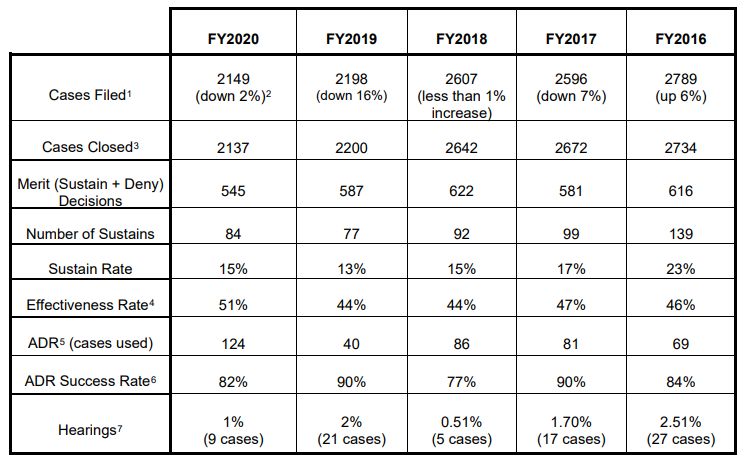On December 23, 2020, the Government Accountability Office ("GAO") issued its annual Bid Protest Statistics for Fiscal Year 2020. As we've previously noted in this blog, the GAO's yearly Bid Protest Report to Congress provides a snapshot of bid protest metrics for each fiscal year, along with data on five-year trends in the GAO's bid protest adjudication. The following chart provides a summary of the GAO's statistics from FY 2020 through FY 2016:

Below are our key takeaways from the FY 2020 report:
- Protesters Obtain Relief More Than 50% of the Time. The GAO's 51% "effectiveness rate" (e., the rate at which a protester obtains some form of relief at the GAO, as a result of either a sustained protest or voluntary agency corrective action) for FY 2020 is a meaningful increase over the 46% average effectiveness rate over the past five fiscal years. That is, of the 1,090 effective protests in FY 2020, the GAO sustained 84 of those cases, meaning that the government took voluntary corrective action in 1,006 other cases.
- FY 2020 Case Filings Continue the Downward Trend From FY 2016. Of the 2,149 cases filed in FY 2020, 2,052 were bid protests. The remainder of cases filed constituted costs claims (66 filings) and requests for reconsideration (47 filings). As compared with the 2,196 cases filed with the GAO in FY 2019, the FY 2020 number represents a 2% reduction. In fact, the FY 2020 number is the lowest in nearly a decade, and a significant drop from the high of 2,789 cases filed in FY 2016. The decrease in FY 2020 filings is the likely result of the COVID-19 pandemic's chilling effect on litigation.
- The Number of Sustained Protests Slightly Increased. Of the 2,149 cases closed in FY 2020, the GAO reached a decision on the merits in 545 cases. However, the GAO sustained only 15% of the protests resolved on the merits-a slight increase from the FY 2019 rate of 13% and on par with the sustain rate in FY 2018. The most common bases for sustaining protests in FY 2020 were (1) unreasonable technical evaluation; (2) flawed solicitation; (3) unreasonable cost or price evaluation; and (4) unreasonable past performance evaluation.
- The Number of Task and Delivery Order Protests Continues to Increase. Consistent with an increase in use of multiple-award contracts, 419 task and delivery order protests were filed in FY 2020-making up 20% of protests filed last year-reflecting a notable increase from FY 2019 numbers (373 protests). This categorical rise is somewhat surprising based on the reduction in protestable task orders resulting from the May 2018 increase of the GAO jurisdictional threshold-from $10 million to $25 million-to hear protests of task or delivery orders under Department of Defense multiple-award contracts.
- A Notable Uptick in Alternative Dispute Resolution Use. Although not entirely surprising given the impacts of the COVID-19 pandemic, the use of ADR to resolve protests experienced a resurgence in FY 2020, as it was employed in 124 cases. This number is more than triple the number of times ADR was used in FY 2019, and is by far the highest in the past five fiscal years. Tempering these numbers somewhat is the dip in the ADR success rate (e., the percentage of cases without a formal GAO decision after ADR) from 90% in FY 2019 to 82% in FY 2020.
At bottom, the GAO bid protest process continues to offer disappointed bidders a significant chance for some type of success. The effective rate of relief afforded to protesters by way of either sustained protests or voluntary agency corrective action has remained remarkably consistent over the past five fiscal years, and the FY 2020 rate of 51% is the highest ever recorded by the GAO. It is important to keep in mind, however, that "relief" doesn't always translate into the protester's receipt of the ultimate contract because agencies have a wide degree of latitude in fashioning corrective action to remedy the alleged defect(s) in the procurement. That said, an agency's voluntary decision to concede error more than half of the time underscores the extent to which protests can serve as a useful tool for contractors.
The content of this article is intended to provide a general guide to the subject matter. Specialist advice should be sought about your specific circumstances.
